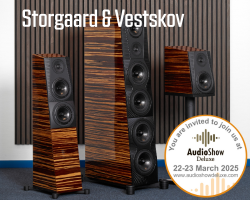ACOUSTIC ENERGY AE1 ACTIVE LOUDSPEAKERS REVIEW
Acoustic Energy AE1 Active loudspeakers are, as the name suggests, active loudspeakers that cost just over £1000. Add a source and you are ready to go. How do they sound at HiFi Pig Towers? Let’s find out.

A nice looking and relatively compact speaker for the modern home.
UK brand Acoustic Energy seem to have been a part of the HiFi furniture for ages. In fact, they were founded in 1987 when they launched their first speaker, the AE1 and I remember it causing quite a stir way back then for such a small loudspeaker. Needless to say, the company has grown and in the mid-nineties, they moved from their London premises to a larger facility in Cirencester following investment from one of their OEM partners where they concentrated on relatively entry-level products like internet radios and Bluetooth speakers. However, the company has been wholly British-owned since 2017. The company has three series of loudspeakers; the 500, 300 and the 100 series and then the product we have here, the AE1 Active.
Now I do like an active speaker and have used them for years, though they have mainly been confined to desktop or studio duties. An active speaker makes a lot of sense in the home – they are compact and you need only add a source to them, preferably with its own volume control, though the AE1s do have onboard volume and tone controls. My only major issue with actives is that they have to be plugged into the mains as they carry their amplification onboard.
FEATURES AND BUILD
The review pair arrived in a gloss black though they are available in Piano White and a real wood Piano Walnut veneer. In black, they are a very handsome-looking speaker.
The main driver is a 125mm ceramic aluminium sandwich cone that is now in its fifth iteration with the idea being that it offers a very stiff cone but is also very light. The tweeter is a newly designed 27mm metal dome and is housed within a Wide Dispersion Technology (WDT) waveguide that aims to allow for a wide stereo image.
The front of the speakers have magnets in them to allow for clipping on the included grilles, though I used them for the duration without, and beneath the woofer is a single white LED to show that the speakers are getting power.
Round the back of each speaker there’s a panel with inputs for both XLR and RCA, the power inlet and switch, a small volume knob and then three-way bass and treble dials. The bass and treble controls are an interesting and I think useful addition to the AE1 Actives and they allow you to adjust both by plus or minus 2dB. The idea here is that if you are forced to have the speakers close to a back wall you can attenuate the bass output to be more in line with the treble output as you naturally get more bass the close the speaker is to a back wall. In much the same way, the treble adjuster is designed to help you mitigate the effects of furnishings in your listening room. In a relatively sparse room you may find it beneficial to reduce the treble output, whereas in a heavily furnished room you may want to decrease the treble output. It’s good to have this kind of thing available as it does allow you to experiment and get the sound that most suits both you and your room. Indeed, the small but perfectly adequate and informative manual that comes with the AE1 Actives suggests that “There are no right and wrong actions to the use of these controls and we recommend you experiment and see what works best for you.” The volume knob is a useful thing to have as it allows you to connect the AE1 directly to a source and control the volume “onboard”, though I didn’t have them set up this way and I would suggest that having to reach behind each speaker to change the volume would get old very quickly. Personally, I think a useful addition here would be a remote control. However, when used as I did the onboard volume control does come in useful and acts as a de facto balance control which will be useful if you have to have the speakers set up less than ideal or your hearing is a tad misbalanced.
Acoustic Energy tells us that the AE1 Active’s cabinets are a new design that benefits from a braced fibreboard construction (18mm MDF) that is damped internally and has a slot port instead of a more conventional circular or flared port.
What you don’t get to see is that inside each of the speakers is a pair of 50W Class A/B amplifiers with AE saying that they have played with Class D and associated DSP designs but found the current amps more appealing sonically.
Claimed frequency response is down to 42Hz which is impressive from a small speaker like this, but it does sort of throw down the gauntlet and says “ Come on, do your worst” on the bass front…and I intend to.

The business end of the AE1 Actives is round the back where you will find all the necessary connections, bass and treble trim, volume, and the slot style port.
All in all, these are nice-looking and well-built active loudspeakers with simple and intuitive controls and good connectivity to existing kit. Acoustic Energy could have gone down the route of including onboard streaming and DAC which I don’t think would be a bad idea at all and would likely widen this speaker’s appeal.
SET UP
The speakers were set up on a pair of solid steel stands, though the AE1 Actives have feet on the bottom should you want to have them on a shelf or desk. Set up was a simple matter of plugging each speaker into a mains outlet and then plugging in an XLR connector to each speaker from our preamplifier. A set of 3m RCA cables is included should you wish to connect them like that but this really does necessitate you having the preamplifier or source between the speakers, not really something that was practical for me with just 3m to play with. Anyway, set up was as hassle-free as you like and I had music within a couple or so minutes.
SOUND QUALITY
I’ve always enjoyed standmount speakers of this kind of size as I find that the better ones do a lot of things that I really enjoy when listening to tunes for my own enjoyment – they are usually half decent at imaging and, for me, that’s an important part of the whole musical enjoyment thing. The AE1 Actives don’t disappoint on this front and Dub Syndicate (initially chosen to cause some bass mayhem) demonstrates that these speakers are certainly very capable in this area. There are lots of effects that fly from channel to channel whilst the bass sits dead centre throughout. Perhaps the perfect tune for chillum-out to as the bass keeps you grounded and the effects let your take your mind with them. In all honesty, I have no complaints about the AE1 and I’d happily sit and listen to these kind of tunes for hours on end, despite my chillum-out days being long gone. That bassline never deviates from being dead centre in the mix with these speakers and delay effects on snare, though more subtle, are easy to pick out if the mix. The same is apparent on the next track (Hey Ho) where the percussion alternates between the left and right speakers. The thought crosses me that I’d be very happy to use these in the studio.
Back to the bass and OutKast’s So Fresh and Clean which has a low bassline that can get lost in the back of the mix behind the bass kick, but the AE1s do a good job of letting you hear it as a separate entity. There’s little overhang in the bass and this makes for a tight and precise bass performance. Whether they go down to 42Hz or not I don’t know, but in this pretty large room, I certainly had no complaints with regards to bass. I’m also impressed with the next track, Ms Jackson, and the snappy take on the reverse sound they use throughout by way of percussion. This could end up sounding like a mush, but it doesn’t.
Ali Farka Touré’s Rouky has intricate and steely guitar throughout and there’s a good sense of its steeliness (steel-stringed guitar) given with the AE1s in place. Detail on the fretboard is easy to hear as is small bends on the strings. However, it’s the realism and small nuances in the playing that stand out. The stage isn’t as expansive as with our bigger floorstanders and the mids aren’t as lush as with our LS3/5As but the truth is there’s bugger all to moan about with the AE1s and a lot to really enjoy and I’ve certainly experienced speakers at shows costing a LOT more sound a lot less accomplished and enjoyable than these relatively modestly priced offerings. When the guitar is picked you can hear the after effect quite clearly and this allows for both an enjoyable listen and a more analytical listen – if that makes sense.

If you don’t like the look of the speakers you can add the magnetic grilles.
Listening to The Nearness of You by Jan Johansson and Rune Gustafsson from the album When The Sun Comes Out there’s a clear sense of the recording space with the hats sounding like tape hiss, which I think is intentional, and the piano sounding lifelike, if not wholly in-the-room as when using our Audiovector R6. You can raise the presence of the speakers a tad by increasing the treble lift, but the truth is I actually preferred the AE1s flat, and other than a bit of a play I left them at that throughout the test period.
It’s a bit of a cliché but Smoke On The Water from Made in Japan is a very good test track in my opinion. Ian Paice’s drums throughout are a lot more intricate than you may initially realise and the AE1s get this over to the listener very well. Likewise, when that growling bass of Roger Glover comes in there’s a good feeling of it being live. This is a busy track and it can sound messy – the AE1s do a good job of making sense of the mess but it’s not as well lineated or separated as with the R3 Audiovectors we still have here, though few will feel the need to whine and most will just enjoy the experience of the tune playing with what is a very good level of detail and excitement.
QUIBBLES
No remote to allow volume control when using a source without its own volume control.
The RCA cables included are 3m on each side which may not be enough for some.
Volume control could do with being on the front of the speakers to avoid having to reach behind them if you aren’t using a device that has variable volume. Either this or a remote control would be a useful addition.
Can get a smidge confused on really busy tracks, but we are splitting hairs here.
Like all active speakers they have to be plugged into the mains and this may well mean that you need to employ longer mains cables.
CONCLUSION
It’s products like the AE1s that let you know that you really don’t need to spend a king’s ransom to get a very respectable sound that will allow you to really enjoy your tunes – put half-decent electronics in front of these speakers and many folk will never feel the need to venture any further down the audiophile rabbit hole, though there are obvious competitors out there like the KEF LS50 and others. Indeed, these speakers really have opened my eyes and have had me thinking about what kind of system we would actually need if and when we retire/downsize.
Personally, I thoroughly enjoyed my time with the AE1 Active loudspeakers. They do a very good job at getting across a musical performance in a way that is exciting and engaging. The pick out for me is in their excellent soundstaging abilities which whilst it may not be as huge and all-encompassing as our R6s, it’s still very good, particularly with regards to separating out the left and right channels and making a whole of it. The soundstage is less good with regards to forward and backward imaging, but it’s the left-to-right thing that most who aren’t over-analysing will take notice of and enjoy.
Bass performance is good and tight and for most people in most listening spaces will be more than adequate. In smaller spaces, or rooms that aren’t well treated, more bass would actually be detrimental to the overall accuracy of the speakers.
From a volume perspective, I was perfectly happy in this larger space and would be hard pushed to take them louder than I did. Most will never get these to the volumes they can play at!
There’s not much throws these speakers at all and I found they were enjoyable with everything from the electro-disco of Tantra’s The Hills of Kathmandu to more intimate jazz recordings like Herbie Hancock’s Riot. However, I do think the AE1 actives really come into their own with the kind of dance and techno music that makes up a good proportion of my listening fodder.
I’d love to see these speakers with an onboard DAC, streamer, and an app to control all that!
AT A GLANCE
Build Quality and Features:
Good looking and well finished in the supplied Piano Black
Easy to set up
The bass and treble controls offer a degree of flexibility with regards to positioning and dealing with room anomalies
The onboard volume controls are invaluable if you are connecting to a line source without its own control. Volume control can also be used as a balance control
No remote which would be useful if setting up with a source without volume control
Sound Quality:
Exciting, detailed, and with a very good left-to-right image
Bass is tight and without overhang making for a solid foundation
The tweeter and its waveguide make for an airy presentation
Value For Money:
This is a pretty busy pricepoint but I’d suggest that the AE1 Actives will hold their own
Given that they sound this good and you can essentially just add a source, I think they are a very good value proposition
We Loved:
The tight, clean, and exciting presentation
Wide and engaging soundstage
XLR and RCA inputs
Ease of setup and positioning
Flexibility of being able to tailor the bass and treble
We Didn’t Love So Much:
Can get a smidge muddled on very busy tracks
No remote, though I appreciate this isn’t essential
Price:
Piano Black / Piano White: UK: £1,050 / $1,600 / Euro 1,300
Piano Walnut: £1,260 / $1,900 / Euro 1,500
(though it seems deals and bundles are available)
Elevator Pitch Review: The Acoustic Energy AE1 Active are a relatively compact active loudspeaker that can be connected to sources with RCA or XLR outputs. They are easy to position and set up and have a degree of tunability with their bass and treble controls, though this is limited. Sonically they are exciting and detailed loudspeakers that are suited to all kinds of music and present a good stage left to right, but less so front to back. They are an excellent proposition and genuinely, like the recently reviewed NuPrime Omnia had me reassess what we’d actually need should we retire and downsize!

Stuart Smith
Review Equipment: Stack Audio streamer and LAB 12 preamplfier.





















































































































































































